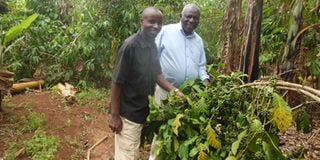How to boost coffee yields amid harsh weather conditions

Coffee farmers practising good agronomy in Luweero including in raising coffee seedlings. Photos by Lominda Afedraru
What you need to know:
- Better farming methods are one way to increase coffee on the market as Lominda Afedraru writes
Coffee is a major agricultural commodity in Africa, including Uganda. It is where most people derive their livelihood because it is mainly grown for commercial benefits.
The main type of coffee produced in Uganda is Robusta and it grows well in low altitude areas of central, eastern, western and southern Uganda up to 1,200 metres.
In Uganda, farmers are growing it mainly around Lake Victoria basin. Uganda’s Robusta coffee is considered to be one of the best in the world and commands a considerable quality.
However, the yield production of coffee in farmer fields is considered to be decreasing as a result of climate change challenges where farmers are experiencing prolonged dry spell and more erratic rainfall that lasts shorter periods.
This weather condition is impacting on the crop at flowering stage, where the flowers tend to abort thereby leading to less and poor quality production of coffee berries.
Other challenges include pests and diseases such as leaf miners, coffee twig borers, mealy bugs, and leaf rust which are on the increase.
Agronomists with expertise in coffee management have observed that it is possible for farmers engaged in coffee growing to indulge in best practices in order to achieve better yields. Joseph Nkandu, a coffee farmer and executive director of the National Union of Coffee Agribusiness and Farm Enterprise (Nucafe), says environmental scientists predicted 50 years ago that Robusta coffee would be wiped out due to increase in temperatures by two degrees celsius.
Giving the statistics to stakeholders during the National Agricultural and Food Security Forum organised by Economic Policy Research Centre (EPRC) in Kampala, Nkandu said the coffee beans in farmer fields has shrunk over the years by 3 per cent per annum. This translates to $27m about (Shs79.3b) loss in of revenue. To regain this revenue, farmers are advised to enrich the soil by applying traditional manure.
Apply fertiliser
During land preparation, the holes where coffee seedlings are planted should be dug one month in advance and 20grammes of Single Super Phosphate (SSP) fertiliser be applied around the plant on the day of planting. This will help in root growth and it makes the plant stable.
After six months, farmers are expected to apply 20grammes of Nitrogen, Phosphorus, and Potassium (NPK) around each plant and 20grammes of potassium around each plant after 10 months when the plants start flowering. Application of the various fertiliser types at different periods will help in healthy growth of the plant, leading to high yield.
Spacing
The spacing of the plants is 3m by 1m and in one hectare land 1,333 plants must be planted. This will enable farmers harvest three metric tonnes of coffee per hectare compared to 0.3 metric tonnes harvested under poor farming practices.
Other farming practices include mulching, pruning of the branches and growing the plants under shed, meaning the coffee farm must contain tree species to provide shed, especially during the dry season.
Temperature control
Shed crops such as bananas have benefits both in the long term for farmers as they help in increasing temperatures and at the same time give short term benefits to farmers by providing additional food and income.
Farmers must ensure that they plant disease free coffee seedlings such as Robusta 1-7 coffee varieties that have been developed by scientists at the National Coffee Research Institute (NaCORI) in Kituuza Mukono.




